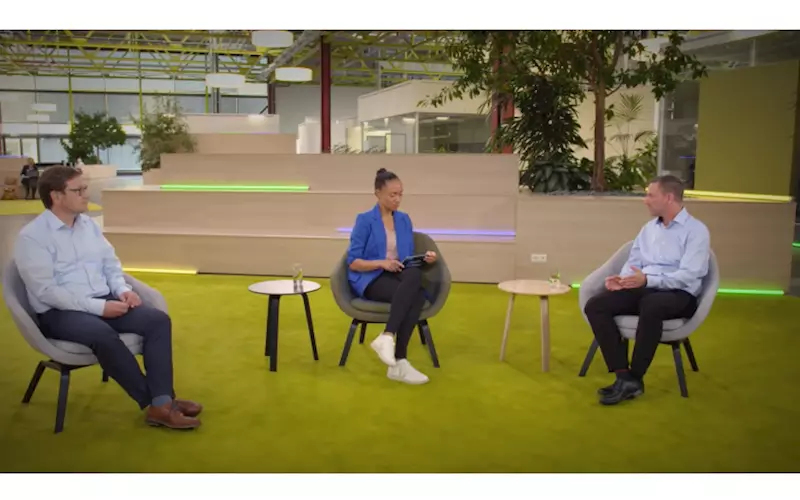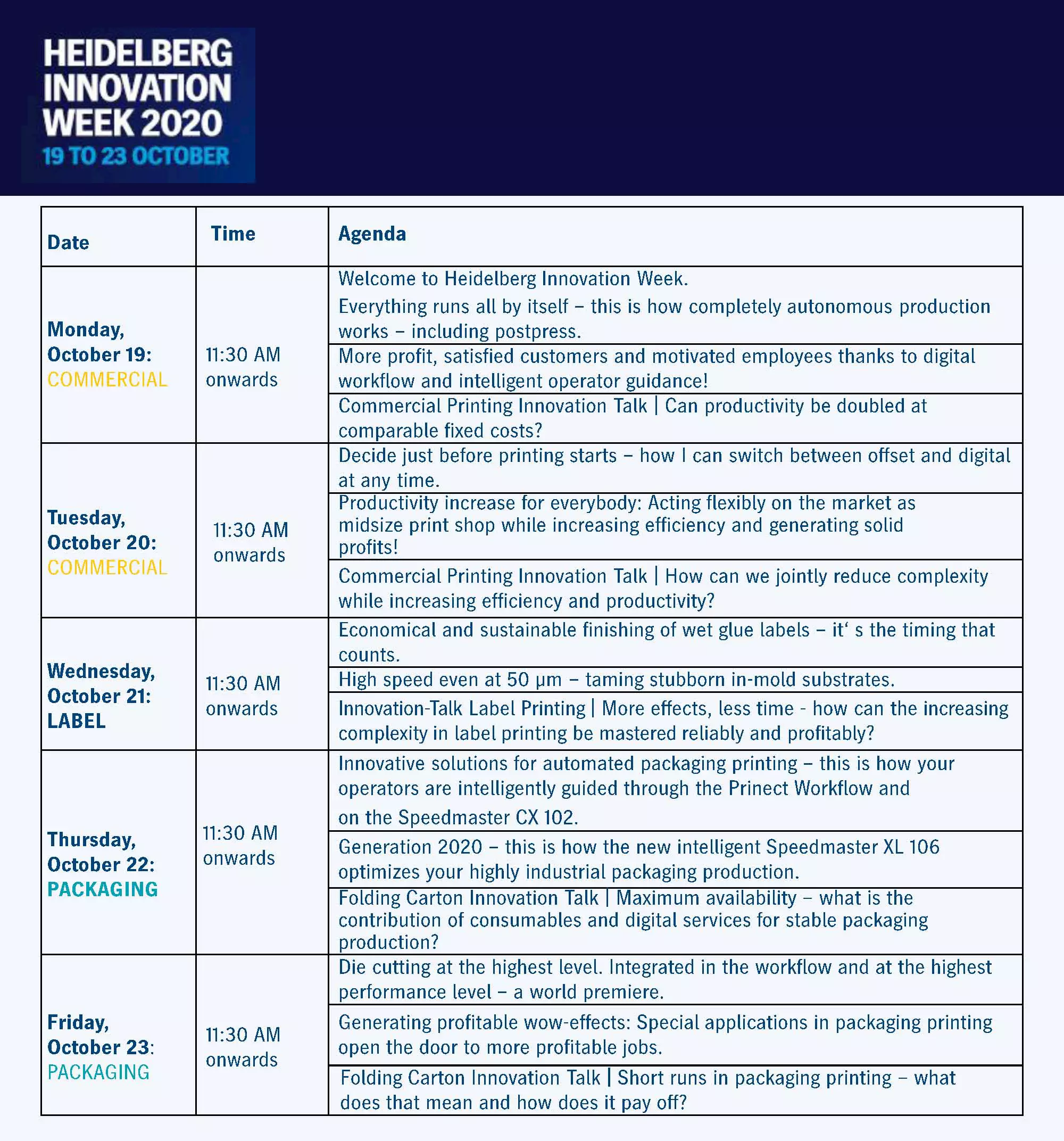Day one of Heidelberg Innovation Week: Doubling productivity at a comparable fixed cost
To increase the productivity of your print shop, the available improvement potentials must be enabled. What are the major potentials and how can they be unlocked? How can this be implemented while daily business is running? What are the benefits of the new contract models?
20 Oct 2020 | By Noel D'Cunha
These and some more topics were discussed, the first in a series of printing innovation talks planned during the event. The discussion was hosted by Yasmine Blair with Rainer Wolf, head of segment management commercial and Oliver Demus, head of customer success management on the panel.
Excerpts:
Yasmine Blair (YB): I'd like to begin with you, Oliver, by asking a very fundamental question, as an opener to our discussion, so to speak, what are the biggest challenges that printing companies face currently?
Oliver Demus (OD): There are many general challenges – one is the ongoing competition between the print shops. It's global consolidation. And on top of it, we have the Covid-19 situation which doesn't help at all. But other than that there are more challenges like one that is internal to the print shop. Processes need to be optimised. Today it’s hard to find qualified operators. That’s internal. Then the biggest challenge I would say, looking from the print shop outside is the customers looking for new clients; globalisation aided by the internet is making it easier for the print buyers to look somewhere else. And then there are the common known challenges like short run lengths and very picky customers. But I think the challenge is: how do I prioritise which challenges to focus on first, work around it to optimise cost and increase profit margins.
YB: Thank you for that opener Oliver. Rainer you've heard about the challenges. What are your solutions to these challenges? What starting points exist for overcoming these challenges together with your customers?
Rainer Wolf (RW): In general, everything has to become smarter. And we have lifted digitization and all the tools in hand to make big progress. Digitisation gives in depth understanding and transparency of the processes through data which can be followed up for improvements. Nothing can be improved without tracking. So that is one of the big assets we have.
Further, digitisation will change the way we interact with our customers and suppliers. We have seen that in the private life already. Now, we'll come to see that in business life as well.
But the biggest potential I see in my environment is how we shape digital process change. If you look at the industry today, we have so many system breaks, where manual data entry is required where systems do not understand each other. So where quality is lacking and faults become visible. The jobs, so to say, are stuck in traffic. There’s a traffic jam.

Blair: The host
YB: I like that metaphor, Rainer, a traffic jam. So naturally, none of your customers would like to be caught in the so-called traffic jam. How do you avoid the traffic jam? I think that your first impulse is probably to want the machines to run quicker. Therefore the solution is to have quicker running machines and quicker productivity.
RW: If it was so easy. But the fact is, it is different. If you are stuck in a traffic jam, a faster, costly car brings no benefit.
We did a thorough analysis of our Speedmaster XL 106 at a recent installation site, and if you look at the graph, the customer's overall equipment efficiency or the OEE factor is an average at 27% that means it is producing at an average of 27% under normal functioning. It also means that there’s a 73% potential for improvement. The question is: is this 73% potential addressable?
If you look at the graph, you can see a gray bar and a yellow bar in the potential. The gray area, almost half of the potential is technology cost. There’s the maintenance and makeready time, as well as some processes which could still be improved. That’s the technical part.
But the other potential is the yellow part that is process-related and, and operator-related. The lost time is not used for productivity because the processes do not support the productivity of the machine.
It is important to understand the mechanics behind them. If you improve the gray bar, and that is what we did in the past. We came up with simultaneous makeready, and a lot of automation. However, we see that not all customers really utilise it, or not to the extent we had expected it to.
So that means, there is no direct link between the gray bar and OEE. What we are doing is working on the yellow bar, and immediately the OEE goes up. And we are targeting the yellow bar with the push-to-stop, end-to-end. We want to have processes where nobody's pushing a button if something happens. We want to shape the entire process in a way that we only push buttons to interrupt if something goes wrong. That's the idea behind it.
We have customers, who are running 90-million sheets per year. This is an incredible number. And if we had no COVID right now, we would have customers running even maybe 100-million this year. Just imagine what that will do to your business, if you can double your production with the same cost.

Demus: Globalisation aided by the internet is making it easier for the print buyers to look at new geographies
YB: Oliver, we would like to know what your approach is at Heidelberg, the machine to support your customers, and what’s the philosophy behind this approach?
OD: Yes, the philosophy is moving forward, it needs to be a partnership between customers and Heidelberg. I think we have broad knowledge about what needs to be done. We have seen many print shops. But also we can't dictate. There needs to be a willingness from the customer to move on in a partnership to get it done.
But often the question is: how much does it cost me to implement it? So, three years ago, we introduced the Heidelberg subscription system or contract, where we deliver the customer everything and take care of those processes from A to Z or from a confirmation all the way to shipping and see what processes can be optimised.
YB: What does the practical implementation then look like? What is your solution? Or how do you then help customers subsequently?
RW: It's both actually. We have to interlink technology with the digital workflow. This is something that we have been working on for years now. I think we have reached a state where you receive a PDF, the pre-press workflow is completely automated. The pre-press understands the MIS and vice-versa. We have the production workflow, the predict production manager, which is a very powerful tool. All the modules are included, but it can be shaped to a customer's needs.
For example, one of the modules is the scheduler, which optimises the jobs in the right way. For example, low colour to high-colour, from large-format to small-format so that there’s only incremental steps from job to job. This job sequence is sent automatically to the CTP with no one touching a plate anymore. The plates are indexed and the trolley they are carried on are also indexed. There auto plate loading feature, printing and an automatic transportation system taking the pile out of the machine to the automated post-press operation. It reduces wastages, there’s saving in cost and it’s good on quality as well. All this is linked with the Prinect system, so that we have productivity data, and full transparency of the process.

Wolf: Digitisation will change the way we interact with our customers and suppliers
YB: What is the role of the operator?
OD: If you have to deliver the double amount of jobs we need to support the operator. So, we have the new Assist systems in place. For example, the powder assist system, which reduces the uses of power such that there’s no post-press issues, no delivery issues and no maintenance issues. The system knows what amount of powder is to be used. Another example is the washer system, which ensures that the operator is able to get the press to deliver a clean result.
But my favourite is the new functionality for Intellirun, which is a software that takes care of the entire printing process, and gives information to the operator in due time in order to avoid downtimes.
In short, the systems help the operator avoid standstills.
YB: Now what we have is the situation where we are on the road, it's smooth sailing all the way, we ensured that there's no traffic jam, they don't need to be caught in a traffic jam. So how does Heidelberg, specifically support its customers to get that extra horsepower on the streets once they have the clear road?
OD: Well, as I mentioned before, with the Heidelberg subscription model the customers have everything they need to get that extra horsepower.
YB: How do you get set up the subscription model? Or how does collaboration start in the first place? And what’s been the customer feedback so far? What are your customers telling you about this model?
OD: Well, first, they were a little hesitant, because everything was new. The model was new, the payment method was new. The customers usually know how much the press costs, they know what the consumable consumption is, and what’s the cost of service. So, we sit with a customer and discuss what the current cost per sheet is. Then we design our project, and show the comparison. See, in the end, our target is to be cheaper today than he was yesterday.
The advantage for the customers is getting a price per impression. And if the system doesn't perform, we put in more training, more consulting whatever is necessary without a cost increase. Because that's our risk, we are that confident that we can increase the performance which is a lot.
We have examples where there's a status quo at the beginning. And then within one year, we were able to reduce the non-productive time (maintenance, lunch breaks and other stoppages) by 30%, which gives you in the end, another 30% higher output.
YB: My closing question to both of you – what is your absolute highlight of the Innovation Week this year?
OD: For me it’s PAT – performance advisor technology. It's kind of an artificial intelligence, where we review the press data and basically provide print shop information of what can be done better in two ways. One to the operator side, where we say there is performance potential in XYZ and these are the suggestions on how to get there.
The other is the information to the management that how much dollar value does it give. We often talk about minutes per job or just 10 sheets per job saved. But if someone does 5,000 or 10,000 jobs in a year, those 10 sheets count up. And therefore, there needs to be the awareness for the management, on the potential saving, because that increases in the profit margins.
RW: That’s a difficult question, because there are so many products and new technologies. But, push-to-stop, end-to-end and everything that is around that is my highlight.












 See All
See All